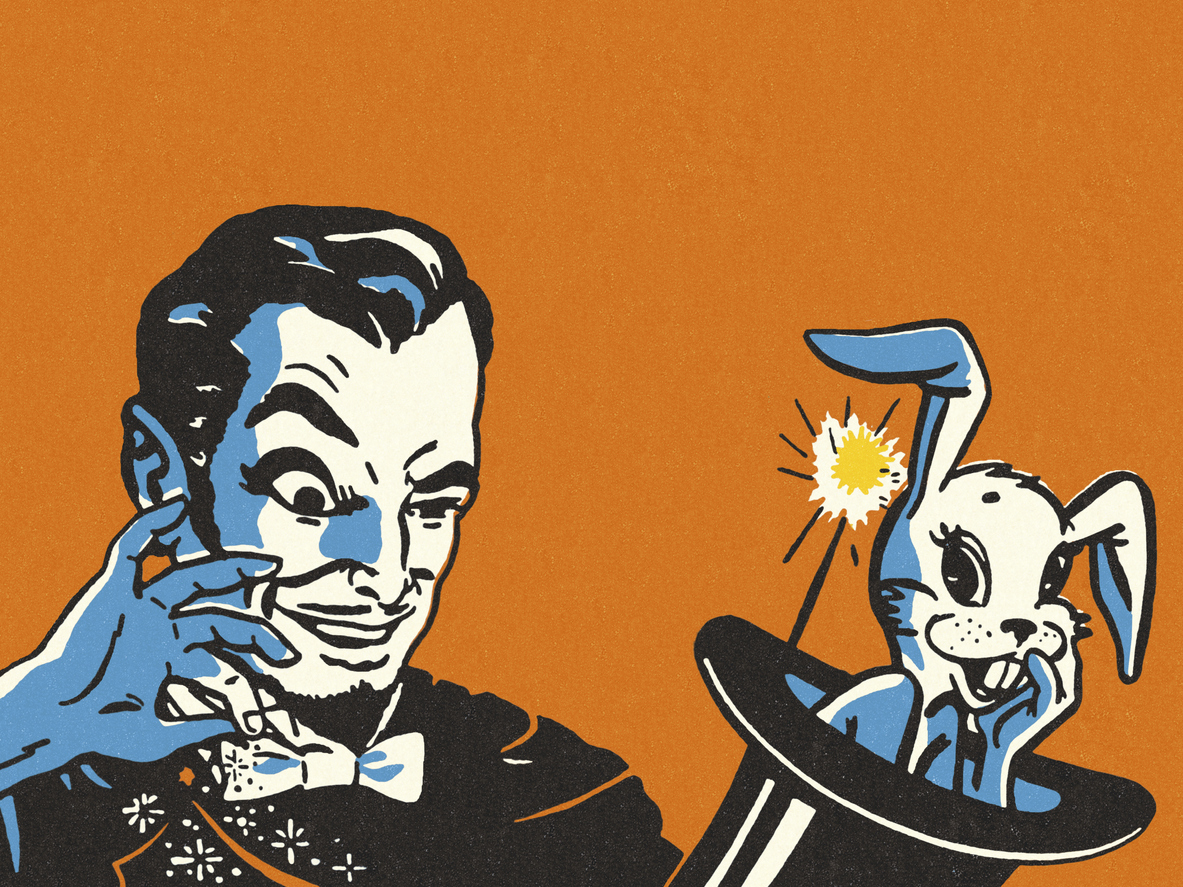There are two ways we can lead our staff. We can lead our team like a magician or lead our staff like a table tennis coach.
One style is disempowering, and one is empowering. One form will produce followers with little initiative, and one will produce leaders who think.
The Magician
Let me explain.
The magician style of leadership is the default position of many of us. Our staff come to us with problems they want us to solve.
Like a magician they want us to pull a rabbit out of the hat. To provide the answers, come up with the solution.
The issues might be significant issues they might be small issues, they may even be trivial, but the magician leader will begrudgingly welcome them all.
Because of this, the magician leader’s day is one of the constant interruptions of team members putting in requests and asking for solutions.
As leaders, we are often well paid, or at least in most cases, paid more than their staff, so we feel an obligation to be spectacular. To come up with the answers. Even when we don’t have the answers, our sense of responsibility in our role and our ego compels us to keep pulling rabbits out of the hat.
We might resent the constant interruptions, but if we are honest, our egos are feed, the hierarchy remains firmly in entrenched, and our expert power established once again.
Why do we often lead like this?
There are many reasons, but here are some common ones.
- It is easier and quicker to provide the solution than it is put it back into their court.
- It feels safe. At least if we are wrong, we are to blame.
- We trust ourselves and our abilities more than the person.
- It is the way leadership we have seen leadership modelled to us.
- It is quick and efficient.
- It feeds our ego.
- It justifies our position and our pay scale and also them and theirs.
- Quality control.
The Challenges of The Magician
There are several problems with this style of leadership.
The first problem with this style of leadership is it doesn’t create a culture of leadership. It creates a culture of leader and subordinates. Ultimately if you want a great business or organisation, you want leadership across the organisation. You want a team of leaders who own the work and wrestle with the problems themselves.
In the magician style of leadership, you create a lasting parent-child relationship where the child never has to grow up in their role fully. They don’t have to own their work, and you remain the parent firmly in control.
The parent role is safe as a leader. You own the work, and your workers implement your work. To have them step away from the child role and into the parental role is risky. It means you have to let go of control. It requires you to share power. It also means allowing things to be done differently from how you would do them. It means the potential for failure, mistakes and stuff-ups.
Leadership guru Peter Block said
“It’s the misuse of our power to take responsibility for solving problems that belong to others.”
The other issue associated with always providing the answers is you’re just not that good. No matter how skilled you are, how deep your knowledge, and how wise you are sooner or later you are going to fudge on the issue and find you have no rabbits in the hat.
The magician leader creates a dependency where the child worker never really has to grows up. The child/work can turn up to work and leave their best at home.
The child/worker in this environment never grows, feels no purpose in work and will leave their best efforts lying inside of themselves. They will die a bit inside each day, dreaming of work which makes them come alive.
The child/worker has also bought into this dysfunctional relationship. They have helped create this co-dependent relationship. The Magician needs them to justify their position and ego, and the child/worker needs the Magician to avoid the pain of growing and taking full responsibility.
The child/worker has a leader who will do the work for them, who will make the tough decisions, carry the weight and wrestle with the problems. They can ‘pass the buck to them’, move the problem ‘up the food chain’ shift responsibility and ownership away from themselves.
So the magician leader is guilty of usurping the responsibly of others in their leadership style, and the child/worker is guilty of acceding their sovereignty for getting the leader to do their work.
Whole organisations and policies in workplaces can strengthen this dysfunction.
There are, however, different ways to lead, ways which grow your team and allow them to be sovereign in their work—genuine ways to empower.
The Table Tennis Coach
One of these ways is simply refuse to be the Magician, instead deliberately choose to operate out of a different leadership style.
Instead of the Magician, you could adopt the style of the table tennis coach. It is a coaching style where the leader’s goal is to develop the team and to see leadership grown.
Leadership starts with owning the work. We develop leadership in our teams by helping them to have ownership of the work.
The table tennis coach has in the core of their being, a desire to grow the person. Their ego is in check. They have no desire to be spectacular, to show them what they know, their purpose is to develop the skills of the player.
The coach helps as much as is necessary, careful not to usurp the work, provide the answers, or to micromanage.
One technique to practice as a leader is to practice hitting the work problem squarely back over the net to the player.
Let me show you how it works.
The child/worker comes into your office with a problem. It might look a little like this.
Child/Worker: “Boss, so and so has happened, what should we do about this?”
The Magician in you might want to pull the rabbit from the hat at this moment.
Magician: “Do this and this, and then this.”
Child/worker: “Thanks, boss.”
Problem solved, time saved back to your work.
But not this time.
You realise that this is a learning opportunity, a growth moment—a chance for them to own the work and thus own leadership.
Instead, you adopt the stance of the table tennis coach.
You hit the ball squarely back into their court.
You do this by simply putting it back on them – framed as a question.
Child/Worker: “Boss, so and so has happened, what should I do about this?”
Table Tennis Coach: “Yes, that’s tricky. What do you think you could do about it?
Child/Worker: “I think I could, x, y and z?”
Table Tennis Coach: “Sounds good to me, how does that sound to you?”
Child/Worker: “Yeah good.”
They leave your office owning the work, more confident in their ability. They move from being the child/worker to embracing leadership.
Now in many cases, it will not be that simple. The parent/child relationship will be firmly entrenched in the organisation and have both you and them in its grip.
It might take a while for;
- You to let go of control.
- Them to trust the culture that you are building, they can fail and not be hauled over the coals later.
- They can trust their insights, skills, knowledge and wisdom to come up with workable solutions.
- To bring their brains and creativity to work.
- To trust, they can own the work and are free to make decisions.
It also might take a while in each conversation to hit the ball back over the net. In other words, some days, you need to be prepared for a long rally.
In this game of table tennis, we keep hitting the problem back over the net through questions.
It might look something like this.
Child/worker: “Boss, so and so has happened, what should I do about this?”
Table Tennis Coach: “Yes, that’s tricky. What do you think you could do about it?”
Child/worker: “I have no idea. It is hard one. What do you think?”
Table Tennis Coach: “Yes, it is a bit of a sticky one. Why don’t you spend a bit of time brainstorming a couple of options? Pick the one you feel most comfortable with and whatever you decide I have your back. If you feel you need to check on again, you can, but you don’t need to. You got this.”
That’s one approach a slam back over the net squarely into their court where they are empowered to think of solutions, make a decision, and you have given them assurance it is safe, and you trust their competence.
Perhaps the person is new in the role, and so they need a bit more guidance. As a leader, you still refuse to become the Magician and choose to remain as the table-tennis coach. You can come alongside them a bit more, not doing it for them. Rather than provide the answers, you might do some joint brainstorming or offer a menu of possible options and get them to choose the one that they think best suits the solution.
Here are some questions to have in your toolbox to help. It can be beneficial to memorise a handful as a manager, so you don’t have to scramble on the spot.
1 – “What can you do about this?”
2- “What is the one thing that matters most in this?”
3 – “What might you need to do right now? And next?
4. – “How can you get from here to there?”
5. “And what else?”
It may make sense at one level to be Magician. It can feel safe, it is familiar, and it can be quicker. The table tennis coach requires us to slow things down, to be more intentional, not to be so ready to offer solutions or to be directive. This style can be frustrating for both them and us. The results are slower, and we don’t get the instant dopamine hit that comes with providing the answers so quickly and readily. Yet the dividends long term are enormous. Little by little, we get our teams to own the work, and as they own the work, the more they lead, bringing their full selves to the workplace.
Copyright G. M Brock © 2020






